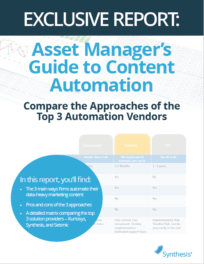Investment Data Marketing: Creating a Cohesive, Data-Driven Story for Your Firm

When meeting and consulting with clients, most investment data specialists refer to 5 datasets managers need to populate in their investment database profiles:
Performance, AUM, Holdings, Characteristics, and Personnel. These are the quantitative datasets. And yes, they are each very important.
However, we at APX Stream believe there are, in fact, 7-9 datasets for which managers need to account. These additional datasets include the qualitative narrative sets: Firm & Product Narratives, Firm & Product Personnel.
But it’s not simply a matter of checking these items off a list every quarter – to successfully execute a professional investment data marketing strategy, managers need to understand, not only the range of data points contained within each set, and account for them accordingly, but how they all work together to create a cohesive, data-driven story for your firm.
All the pieces must fit, and do so in a way that entices database subscribers (i.e. your future clients & investors) to pick up the phone or dash off an email inquiring about your portfolio management services.
So how should these pieces fit together and what are some ideas managers can employ to help improve their data marketing execution?
Firm and Product Narratives
Narratives are unquestionably the most under-nurtured dataset in all of data marketing.
Writing a great narrative might not feel as exciting as generating great performance, but without it, performance counts for very little.
That’s a bold statement, but it’s a hill we at APX Stream are willing to die upon. Why?
Because in the real world, quantitative numbers are what substantiate the firm and product narratives – not the other way around. A database profile with great performance, but narratives that are lackluster, uninspiring, or missing entirely generate little enthusiasm in the hearts and minds of database users.
Understand that most database subscribers aren’t performance chasing – they are looking to make informed, thoughtful decisions; in other words, not make dumb mistakes. And a big part of not making dumb mistakes is avoiding firms that fail to present themselves to the marketplace in a professional manner.
What makes for a “professional” strategy?
Transparency, thoughtfulness, and effort.
It’s the narratives that provide context for the performance, not the other way around. And having the proper tools to help fashion and maintain the narratives not only saves time but increases the efficacy of data marketing.
Investment Data Webinar | Access Replay Below
Vehicle Performance
About as straightforward as it gets. Performance is commonly understood to be the most important dataset – at least for the managers. Accurate, timely, and consistently reported performance (both gross & net) is a no-brainer.
Vehicle Holdings
Many managers get a little skittish when it comes to reporting their holdings. We respect that reluctance; after all, it makes sense that publishing vehicle holdings could compromise a firm’s competitiveness by showing the world (competitors included) exactly how the investment process plays out in the real world.
But that’s exactly why you need to publish your holdings. Database subscribers need to see exactly how your selection process works in practice. Proof is in the pudding.
And don’t forget vehicle holdings are what give rise to portfolio characteristics and performance – portfolio performance is calculated from the individual holdings.
In this way, vehicle holdings are an important part of substantiating your firm’s story. For example, if a manager says they are a micro-cap manager with a contrarian bent, but the top-10 holdings include Tesla, Facebook, and Home Depot, it says something about either your self-awareness or your candor.
Either way, it’s not a good look. Publish your holdings.
(But if you still refuse to do so, then be sure you are robust in your treatment of your portfolio characteristics datasets – see below)
Vehicle Portfolio Characteristics
The Portfolio Characteristics are the datasets that are at once among the most profound, but also the most granular.
Characteristics can be viewed as a portfolio’s diagnostics test. While holdings datasets show what you’ve bought, portfolio characteristics offer a snapshot of how all the holdings interact with each other. In other words, do the collection of underlying holdings work to create a portfolio that is healthy… or ill? Performance can be highly misleading unless viewed in the context of portfolio characteristics.
That said, there is a fine line between being too transparent and too opaque – striking the right balance is important.
Balance transparency with the degree of “mysterious allure” in order to prompt an unsolicited inquiry from a database subscriber.
Firm AUM & Breakdowns
Again, it’s about substantiation and transparency.
- With whom do you work?
- How much in assets do you manage?
- How much revenue does your firm generate?
- How many total accounts?
For a consultant performing due diligence, these are all important questions.
Remember – Priority #1 for many database users isn’t necessarily maximizing returns, but avoiding mistakes.
Delineating your client demographics establishes credibility among your target markets (i.e.: working with one pension makes it easier to land another).
Product AUM & Breakdowns
Many database subscribers also need to know the assets held in your various products & vehicles.
Our hypothetical micro-cap, contrarian manager likely shouldn’t have $20 billion AUM in a given product if they claim to be nimble and opportunistic – a prerequisite if one is to work in that niche with any measure of effectiveness. Few AUM? It’s an important point of transparency as well and can offer a meaningful opportunity for dialogue.
Be transparent here.
Firm Personnel
Perhaps the most important question your firm personnel datasets can answer is: are the folks responsible for long-term performance still working at the firm? Lots of employee turnover at portfolio management positions is a crimson red flag.
Firm Personnel can also answer other important questions such as
- Can you handle the work?
- Can you service your accounts?
Is there adequate back-office staff to make the business side of the firm run smoothly?
There are other questions that can be raised and answered by a careful analysis of a firm’s personnel.
For example, an investment process narrative that’s heavy on research and uncovering hidden gems, but with a 3-member investment team that’s been together for 20 years? It could be very effective, but it’s also not exactly a crucible for original, truly independent thinking and fresh perspectives.
APX Stream has also seen managers double- and triple-count employees in their Firm Personnel characteristics.
For example, a portfolio manager that’s also a CIO and CCO? Sorry – that’s one employee, not three. You might be surprised how many firms try to shade their firm personnel thusly. It is terribly short-sighted and easy to detect once due diligence moves past the initial stages. And if you get caught, it is often disqualifying.
Product Personnel
Product personnel is where the rubber hits the road. Here, experience, education, and general background play a vital part in establishing credibility and transparency. Strategies with dozens and dozens of names across several industries, for example, require more than a 2-member investment team to properly vet and select appropriate candidates.
In sum…
Approach the construction of your database profile like you would a college term paper. Anything you say, anything you claim, any assertions that are presented as fact must be substantiated by evidence. Anything that doesn’t necessarily support your topline message? Still present it in the name of transparency – just make sure you explain it persuasively and honestly.
The database profile is the best chance you have to build credibility – or lose it- in advance of the relationship.
Be thoughtful.
This post was written for the Synthesis Technology blog by Daniel Quinn, CMO at APX Stream.
Here are some related resources that might interest you:







 Compare the Top 3 Finserv Content Automation Vendors [White paper]
Compare the Top 3 Finserv Content Automation Vendors [White paper] Create Pitchbooks the Drive Sales [White paper]
Create Pitchbooks the Drive Sales [White paper] Build vs. Buy: Should Your Financial Services Firm Outsource or Insource Marketing Technology? [White paper]
Build vs. Buy: Should Your Financial Services Firm Outsource or Insource Marketing Technology? [White paper]  10 Tips for Rebranding your Fund Marketing Documents [White paper]
10 Tips for Rebranding your Fund Marketing Documents [White paper]

